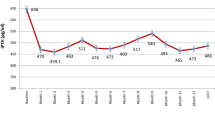Abstract
Feline chronic renal failure was recognized with increased frequency in Maine coon, Abyssinian, Siamese, Russian blue, and Burmese cats. The objective of this study was to investigate the relationship between parathyroid hormone (PTH) level, calcium, and phosphorus homeostasis and the development of various stages of the naturally occurring chronic renal failure (CRF) in cats. Thirty-two CRF cats without history of receiving special diet for renal diseases that were presented to the Small Animal Hospital, Faculty of Veterinary Science, Chulalongkorn University were studied. Nineteen CRF cats were followed prospectively for 60 days and divided into two groups: uremic group (11 cats) and end-stage group (eight cats). The control group (13 cats) were normal cats, which were brought for vaccination at the same hospital within the same period. CRF cats with blood urea nitrogen concentrations of more than 50 mg/dl, serum creatinine level of more than 2.1 mg/dl, and urine specific gravity of between 1.008 and 1.014 were included into the study. Completed blood count, blood chemistry, electrolytes, including sodium, potassium, total calcium, and phosphorus, and PTH levels were measured on days 0, 14, 30, and 60 after the first diagnosis. The results showed that cats with CRF had significantly lower red blood cells, hemoglobin, and pack cell volume than control cats (p < 0.01) on days 0, 14, 30, and 60. PTH levels on first day of diagnosis were 50.51 ± 19.65, 79.41 ± 28.12, and 183.37 ± 50.12 pg/ml in controls, uremic, and end-stage groups, respectively. Cats in end-stage group had significantly increased levels of PTH when compared to control (p < 0.01) and uremic groups (p < 0.05) on days 0, 14, and 30. Serum phosphorus levels also increased significantly in end-stage group (p < 0.001), indicating the presence of renal secondary hyperparathyroidism. This study reveals that PTH level is significantly increased in end-stage CRF cats who did not received special diet for renal diseases. The development of renal secondary hyperparathyroidism in end-stage CRF cats significantly decreased its survival rate.






Similar content being viewed by others
References
Barber PJ, Elliott J (1998) Feline chronic renal failure: calcium homeostasis in 80 cases diagnosed between 1992 and 1995. J Small Anim Pract 39(3):108–116
Barber PJ, Elliot J, Torrance AG (1993) Measurement of feline intact parathyroid hormone: assay validation and sample handling studies. J Small Anim Pract 34:614–620
Barber PJ, Torrance AG, Elliot J (1994) Carboxyl fragment interference in assay of feline parathyroid hormone. J Vet Intern Med 8:168
Barsanti JA, Lees GE, Willard MD, Green R (2007) Urinary disorders. In: Willard MD, Tvedten H, Turnwald GH (eds) Small animal clinical diagnosis by laboratory methods, 4th edn. Saunders, Philadelphia, pp 135–164
Block GA, Hulbert-Shearon TE, Levin NW, Port FK (1998) Association of serum phosphorus and calcium x phosphorus product with mortality risk in chronic hemodialysis patients: a national study. Am J Kidney Dis 31:607–617
Brown SA, Crowell WA, Barsanti JA et al (1991) Beneficial effects of dietary mineral restriction in dogs with marked reduction of functional renal mass. J Am Soc Nephrol 1:1169–1179
Brushinsky D (1998) Disorders of calcium and phosphorus homeostasis. In: Greenberg A (ed) Primer on Kidney Diseases, 2nd edn. Academic, San Diego, pp 106–113
Chew D, Nagode L (1992) Calcitriol in treatment of chronic renal failure. In: Kirk R, Bonagura J (eds) Current veterinary therapy XI. Saunders, Philadelphia, pp 857–860
DiBartola SP, Rutgers HC, Zack PM et al (1987) Clinicopathologic findings associated with chronic renal disease in cats: 74 cases (1973–1984). J Am Vet Med Assoc 190:1196–1202
Elliot J, Barber PJ (1998) Feline chronic renal failure: clinical findings in 80 cases diagnosed between 1992–1995. J Small Anim Pract 39:78–85
Eschbach JW, Adamson JW (1991) Hematologic consequences of renal failure. In: Brenner BM, Rector FC (eds) The kidney, 4th edn. Saunders, Philadelphia, pp 2019–2022
Felsenfield A (1997) Consideration for the treatment of secondary hyperparathyroidism in renal failure. J Am Soc Nephrol 8:993–1004
Finco D, Brown S, Crowell WA et al (1992) Effects of dietary phosphorus and protein in dogs with chronic renal failure. Am J Vet Res 53:2264–2271
Fine LG, Orphanides C, Norman JT (1998) Progressive renal disease: the chronic hypoxia hypothesis. Kidney Int 53(suppl 65):s-74–s-78
Kates DMA (1996) Control of hyperphosphatemia in renal failure: role of aluminum. Semin Dial 9:310–315
Kates DM, Sherrard DJ, Andress DL (1997) Evidence that serum phosphate is independently associated with serum PTH in patients with chronic renal failure. Am J Kidney Dis 30:809–813
Lulich JP, O'Brien TD, Osborne CA et al (1992) Feline renal failure: questions, answers, questions. Compend Contin Educ Pract Vet 14:127–152
Martinez I, Saracho R, Montenegro J, Llack F (1997) The importance of dietary calcium and phosphorus in the secondary hyperparathyroidism in patients with early renal failure. Am J Kidney Dis 29:496–502
Nagode L, Chew D, Steinmeyer C et al (1993) Renal secondary hyperparathyroidism: toxic aspects, mechanisms of development and control by oral calcitriol treatment. Eleventh Annual Veterinary Medical Forum, Washington, DC, pp. 154–157
Polzin DJ, Osborne CA, O'Brien TD (1989) Diseases of the kidneys and ureters. In: Ettingers SJ (ed) Textbook of veterinary internal medicine, 3rd edn. Saunders, Philadelphia, pp 1963–2046
Polzin DJ, Osborne CA, Jacob F, Ross S (2000) Chronic renal failure. In: Ettingers SJ (ed) Textbook of veterinary internal medicine, 5th edn. Saunders, Philadelphia, pp 1634–1662
Pusoonthornthum R, Pusoonthornthum P, Trisiriroj M, et al (2001) Changes in serum and urine electrolytes in cats with chronic renal failure. Annual Case Conference Report. Faculty of Veterinary Science,Chulalongkorn University. pp. 31–35
Acknowledgments
The study was supported by a grant from The Thailand Research Fund.
Author information
Authors and Affiliations
Corresponding author
Rights and permissions
About this article
Cite this article
Pusoonthornthum, R., Pusoonthornthum, P. & Krishnamra, N. Calcium-phosphorus homeostasis and changes in parathyroid hormone secretion in cats with various stages of spontaneous chronic renal failure. Comp Clin Pathol 19, 287–293 (2010). https://doi.org/10.1007/s00580-009-0844-5
Received:
Accepted:
Published:
Issue Date:
DOI: https://doi.org/10.1007/s00580-009-0844-5




